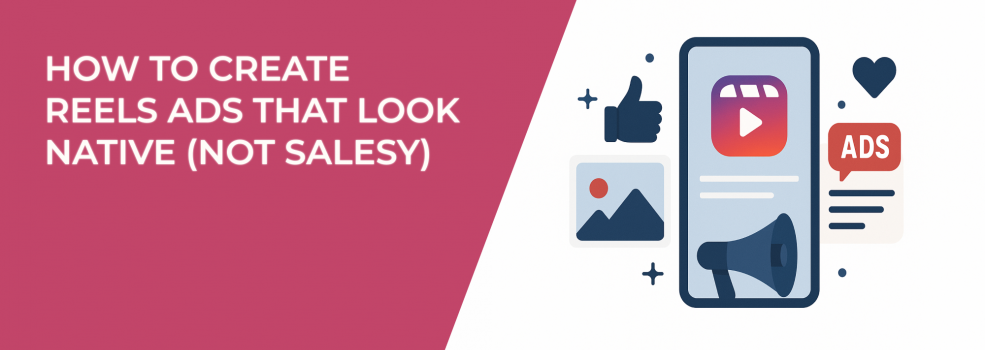Reels are everywhere. Whether you’re scrolling through Instagram or Facebook, short-form video is dominating feeds and commanding attention. For advertisers, this is both an opportunity and a challenge. The opportunity? Reels ads deliver high engagement and can drive impressive conversions. The challenge? Users can spot a salesy ad from miles away and swipe past it in seconds.
That’s why creating Reels ads that look native (not salesy) has become one of the most effective strategies for marketers in 2025. Let’s dive into exactly how to do it — step by step.
Why Native Reels Ads Perform Better
When your ad blends into the content people are already watching, it feels less like a disruption and more like entertainment. This is critical for platforms like Instagram and Facebook, where users come for content that feels fun, relatable, and authentic.
Research shows that user-generated style content often outperforms traditional branded videos. Why? Because it feels real. It mirrors the way friends, influencers, or creators post. Native-looking Reels ads build trust faster and spark curiosity, which makes people more likely to stop scrolling.
Think about it: if you’re watching a Reel about a recipe, which ad would you watch — a glossy commercial for cookware, or a casual, creator-style video of someone cooking with it in their own kitchen?
Step 1: Nail the Format from the Start
The first step to making your Reels ads feel natural is to respect the platform’s format. Reels are vertical, fast-paced, and often consumed with the sound off.
Here are a few must-follow guidelines:
-
Film vertically (9:16 ratio): Nothing looks more out of place than a horizontal ad forced into a vertical feed.
-
Keep it short and sharp: 15–30 seconds is the sweet spot. Longer ads rarely hold attention.
-
Design for sound-off viewing: Add captions or bold on-screen text so the message is clear without audio.
-
Use native transitions: Quick cuts, swipes, and zooms mirror what creators are already doing.
This isn’t about lowering quality — it’s about matching expectations. Your ad should feel like it belongs in the Reels environment, not like it was copied from TV.
Step 2: Hook Viewers in the First 3 Seconds
The opening seconds of a Reel are everything. If you don’t grab attention immediately, the ad is over before it begins.
Try these attention-grabbing techniques:
-
Start with a surprising visual (before/after reveal, bold movement, or unexpected angle).
-
Use trending audio that catches the ear instantly.
-
Ask a curiosity-driven question on-screen.
-
Show a human reaction — a laugh, a gasp, or a relatable expression.
A strong hook doesn’t need to feel pushy. It should spark curiosity so viewers want to keep watching.
Capturing attention quickly isn’t just about visuals, it’s rooted in psychology — and our article on The Psychology of Facebook Ads: How to Hook Your Target Audience in Second dives into exactly how this works.
Step 3: Mirror Organic Reels Content
The easiest way to avoid looking “salesy” is to study what real creators are posting — then borrow the same style.
That might mean using trending sounds, casual language, or even the kind of shaky, handheld camera work that makes videos feel personal. Avoid overproducing. If your ad looks like a big-budget TV spot, it’s already out of place.
Examples of organic-style content that works as Reels ads:
-
A quick product demo shot on a phone.
-
A behind-the-scenes peek at how something is made.
-
A lifestyle clip showing your product in a real-world setting.
The more it looks like content users would watch anyway, the better.
Native-style videos often work even better when combined with creator-style assets, similar to what we explored in How to Use User-Generated Content in Your Facebook Ads for Authentic Engagement.
Step 4: Highlight People, Not Just Products
People connect with people. Showing your product in action, through the hands and faces of real users, instantly makes your ad feel more human.
Instead of a static product shot, try:
-
A short testimonial clip in selfie style.
-
An unboxing reaction with real excitement.
-
A quick “how I use this every day” clip.
Think of your ad as storytelling, not just showcasing features. Viewers are far more likely to remember how someone felt using your product than a polished list of specs.
Step 5: Keep the Message Simple and Focused
Reels move quickly, so don’t overload them with information. Focus on a single idea or benefit.
Ask yourself:
-
What’s the one action I want viewers to take?
-
What’s the simplest way to communicate that in under 20 seconds?
A skincare brand might highlight one key ingredient. A SaaS company might demonstrate one feature that saves time. Simplicity makes the ad feel authentic and prevents it from turning into a hard sell.
Step 6: Use Trends Without Losing Brand Voice
Trends are the lifeblood of Reels. Music, filters, and challenges can help your ad feel native — but only if they make sense for your brand.
For example:
-
A fitness brand might use a trending transition to show workout progress.
-
A food brand could sync recipe steps to a viral song.
-
A tech brand could use a popular meme format to simplify a complex concept.
The trick is to participate without forcing it. Choose trends that enhance your message, not distract from it.
Step 7: Test, Measure, Refine
Even the most “native-looking” ads won’t succeed without optimization. Reels ads are fast-moving, and audience preferences shift quickly.
Keep testing variables like:
-
The opening hook (visual vs. text-driven).
-
Creator style (professional vs. casual).
-
Audio (music vs. voiceover vs. silence).
-
Call-to-action placement (start, middle, or end).
Measure watch time, engagement rates, and conversions. Use the data to cut what doesn’t work and double down on what does.
If you’re not sure which creative to start testing first, this breakdown of What to Test First: Creative, Copy or Audience in Facebook Campaigns? gives a solid framework.
Bonus Tips for Making Reels Ads Look Native
1. Blend Design Elements
Reels thrive on playful visuals. Adding Instagram-style stickers, emojis, or captions can make your ad look like something a creator would naturally post rather than a polished commercial.
For example:
-
A coffee brand could overlay a “Monday Mood” sticker on a morning latte video.
-
A clothing retailer might add swipe arrows or animated text to point out outfit details.
-
A SaaS company could use simple pop-up captions to emphasize quick benefits, like “Save 2 hours a day.”
These small touches make the ad feel less corporate and more conversational.
2. Add Subtle Branding
Overbranding is one of the fastest ways to lose credibility on Reels. A logo plastered across the screen screams “ad.” Instead, keep branding subtle — think of it as a watermark rather than a billboard.
Practical ideas:
-
Place a small logo in the top or bottom corner, similar to how creators watermark their content.
-
Use your brand colors in on-screen text or captions without directly calling it out.
-
End with a branded outro — a two-second tag or animation feels natural while reinforcing brand identity.
Subtle branding makes sure your message sticks without interrupting the viewing experience.
3. Think Like a Creator
Before hitting publish, ask yourself: Would this feel natural if I saw it in my own feed? If the answer is no, adjust. This mindset shift is powerful because creators focus on relatability and entertainment first, while brands often focus too much on selling.
For example:
-
Instead of a formal product demo, film a quick “day in the life” using your product.
-
Use trending audios the way creators do — synced to a funny or relatable moment.
-
Embrace imperfections: a slightly shaky camera or unpolished cut can actually improve authenticity.
By stepping into the shoes of a creator, you align your ad with the expectations of Reels viewers.
4. Prioritize Relatability
Reels aren’t about perfection — they’re about connection. Ads that feel too staged or corporate often come across as distant. Relatability, on the other hand, builds trust.
Examples of relatable approaches:
-
A fitness brand could show someone trying (and slightly struggling) with a new exercise before finally nailing it.
-
A food brand might share a quick recipe fail that turns into a win — something viewers laugh with and relate to.
-
A travel brand could highlight “real” moments like messy luggage, not just picture-perfect beaches.
Relatable ads remind viewers that the brand understands them. They feel less like promotions and more like shared experiences.
Final Thoughts
Creating Reels ads that look native isn’t about tricking people into watching. It’s about respecting the platform, speaking the language of the audience, and delivering value in an entertaining way.
When you get it right, your ads don’t just blend into the feed — they stand out because they belong there. And that’s what drives attention, trust, and ultimately, conversions.

